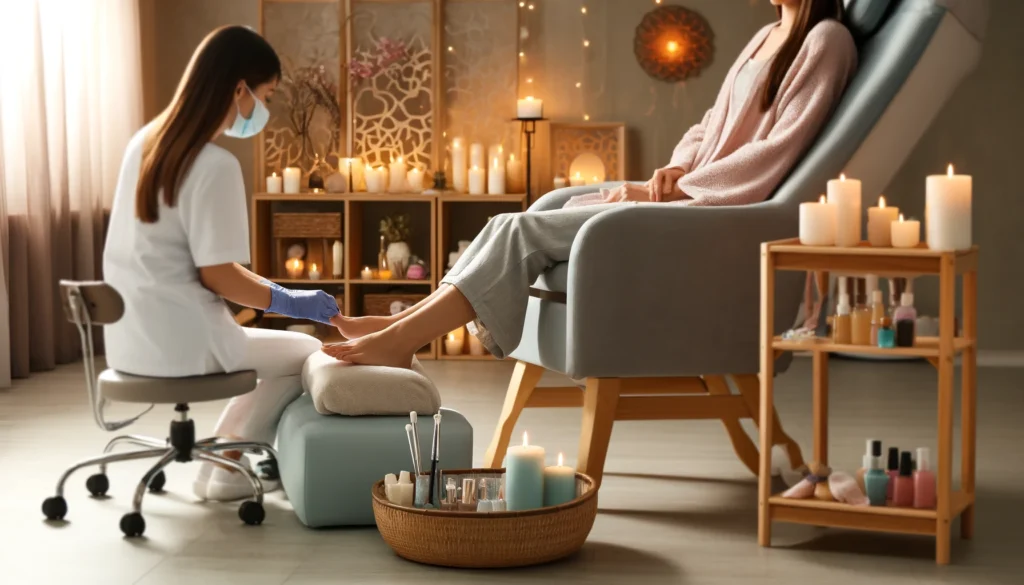1. Introduction
Pedicures are a popular cosmetic treatment for the feet and toenails, offering both aesthetic enhancements and health benefits. Originating from ancient Egypt and Rome, pedicures have evolved over centuries into a refined practice available in salons and spas worldwide. Regular pedicures not only keep your feet looking their best but also promote overall foot health by preventing nail diseases and improving circulation. This article delves into the various types of pedicures, their benefits, and a step-by-step guide to performing a pedicure at home.

2. Types of Pedicures
- Classic Pedicure: A standard treatment involving nail trimming, cuticle care, exfoliation, and nail polish application.
- French Pedicure: Characterized by a natural pink base and white tips, offering a chic, clean look.
- Gel Pedicure: Uses gel-based polish cured under UV light for a long-lasting, chip-free finish.
- Spa Pedicure: Includes additional pampering such as foot masks, paraffin wax, and extended massage.
- Paraffin Pedicure: Involves dipping the feet in warm paraffin wax to soften and moisturize the skin deeply.
- Fish Pedicure: Small fish nibble away dead skin cells, providing natural exfoliation (note: this method is controversial and not widely recommended due to hygiene concerns).
3. Benefits of Getting a Pedicure
- Aesthetic Benefits: Keeps toenails trimmed, shaped, and polished, enhancing the overall appearance of your feet.
- Health Benefits: Regular pedicures can prevent nail diseases and disorders, reduce the risk of infections, and help detect early signs of corns, bunions, and fungal infections.
- Psychological Benefits: The process of getting a pedicure is relaxing and can reduce stress, promoting a sense of well-being and self-care.
4. Step-by-Step Guide to a Basic Pedicure
- Preparation: Gather essential tools—nail clippers, files, foot scrub, cuticle pusher, moisturizer, and nail polish.
- Soaking the Feet: Soak feet in warm, soapy water for 10-15 minutes to soften the skin and nails.
- Exfoliating and Scrubbing: Use a foot scrub or pumice stone to remove dead skin cells, focusing on heels and calluses.
- Trimming and Shaping the Nails: Cut nails straight across to avoid ingrown toenails, then file to smooth edges and shape.
- Cuticle Care: Gently push back cuticles with a cuticle pusher and trim any excess skin if necessary.
- Moisturizing and Massaging: Apply a rich foot cream or moisturizer, massaging it into the skin to enhance circulation and relaxation.
- Applying Nail Polish: Apply a base coat, two layers of colored polish, and a top coat, allowing each layer to dry completely.
5. DIY Pedicure vs. Professional Pedicure
- Advantages of a DIY Pedicure: Cost-effective, convenient, and customizable to personal preferences. You can perform a pedicure at any time without needing an appointment.
- Advantages of a Professional Pedicure: Offers professional expertise, access to high-quality products, and a more luxurious experience with advanced treatments like paraffin wax and extended massages.
- Cost Comparison: DIY pedicures are cheaper, requiring only the initial investment in tools and products, while professional pedicures range from $20 to $60 depending on the salon and location.
- When to Choose a Professional Pedicure: Opt for professional care if you have foot problems, want a more relaxing experience, or need advanced treatments that are difficult to perform at home.
6. Common Pedicure Tools and Products
- Nail Clippers and Files: Essential for trimming and shaping nails.
- Foot Scrubbers and Pumice Stones: Used to exfoliate dead skin and smooth calluses.
- Cuticle Pushers and Trimmers: Important for managing cuticles without damaging the nail bed.
- Moisturizers and Foot Creams: Keep the skin hydrated and soft.
- Nail Polish and Removers: Essential for adding color and removing old polish efficiently.
7. Safety and Hygiene Tips
- Sterilizing Tools: Always sterilize tools before and after use to prevent infections.
- Choosing a Reputable Salon: Ensure the salon follows strict hygiene protocols, including sterilizing tools and using fresh water for each client.
- Avoiding Infections and Fungal Diseases: Do not share pedicure tools, and seek immediate treatment if you notice signs of infection.
- Post-Pedicure Care Tips: Moisturize regularly, wear breathable footwear, and keep nails trimmed and clean.
8. Popular Pedicure Trends (200 words)
- Nail Art and Designs: From minimalist designs to elaborate nail art, current trends include geometric patterns, floral motifs, and seasonal themes.
- eco-friendly and Organic Pedicures: Increasing demand for eco-friendly products has led to the use of organic and cruelty-free polishes and foot care products.
- Seasonal Trends and Colors: Bright colors for summer, dark hues for winter, and special holiday-themed designs.
- Celebrity-Inspired Pedicures: Influences from celebrities often set trends, such as unique color combinations or nail art styles seen on red carpets.
9. FAQs
- How often should you get a pedicure?
- It’s recommended to get a pedicure every 4-6 weeks to maintain foot health and nail appearance.
- Can diabetics get pedicures?
- Yes, but they should choose salons carefully and inform the technician about their condition to avoid cuts or infections.
- What should you do if you experience pain during a pedicure?
- Inform the technician immediately to adjust the treatment. Pain should not be part of the pedicure experience.
- Are pedicures safe during pregnancy?
- Yes, but pregnant women should avoid exposure to strong chemicals and fumes. Opt for well-ventilated salons and consider using non-toxic products.
External Articles:
- American Podiatric Medical Association: Foot Care Tips – “foot care tips”
- WebMD: Benefits of Pedicures – “benefits of pedicures”
- Mayo Clinic: How to Prevent Nail Infections – “prevent nail infections”
- Healthline: DIY Pedicure Guide – “DIY pedicure guide”
- Allure: Latest Pedicure Trends – “latest pedicure trends”





